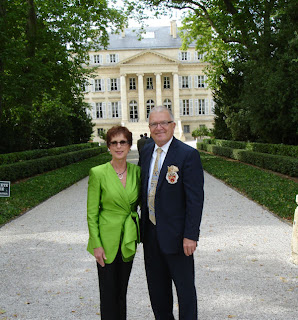Our group with Jean-Michel Caze. David, Kent, Elizabeth, Jean-Michael, Chuck, Peter, Patricia and Jeff
Chateau Lynch (pronounced "Linch" not "Launch" as I had become accustomed to calling it) Bages is located but a stones throw from the City of Pauillac. Thomas Lynch, whose father John emigrated in 1691 from Ireland to Bordeaux, inherited an estate in the village of Bages through his wife, Elizabeth, in 1749. The estate was purchased by the Caze family in 1938. After Jean-Charles Cazes' death, aged 95, in 1972, the estate has been largely managed by his grandson, Jean-Michel Cazes. Caze is, according to many people, one of the real movers and shakers in Bordeaux, who has had a huge impact on it and the Bordeaux wine business. The estate includes about 220 acres of land and produces about 25,000 cases of wine per year, mostly red although it does make a white wine, Chateau Lynch Bages Blanc.Peter with Jean-Michel Caze.
During our tasting we tasted barrel samples of the 2010 Echo (their 2nd wine) and their 2010 Lynch Bages. Both were interesting and very attractive wines. The 2011 Lynch Bages will be a blend of 75% Cabernet, 15% Merlot, 8% Cabernet Franc and 2% Petit Verdot.
The wine making process at Lynch Bages is a bit different that most other Chateau in the Medoc. They sort their grapes on portable sorting tables in the fields before they are delivered to the winery. We obviously did not see this process, but I imagine that it is not as detailed and specific as happens with many people on a sorting table in the winery, The grapes are then delivered to the winery and dumped into a large hopper with a screw conveyor in the bottom. They are then destemmed, crushed and pumped into the tanks. I must say I was a bit disappointed in the winery operation. This is, and always has been, one of my favorite wines. It continues to be. But, their equipment and winery shows its age and is in dire need of an update to keep pace. To me they seemed decades behind the other wineries that we saw. Galvanized steel catwalks above the tanks, that were probably constructed 50 years ago should be replaced by stainless. Screw conveyors are in need of conversation to gravity handling and crushing probably needs to be replaced with whole berry fermentation. Jean - Michel Cazes did say that his son was now running the operation and had significant plans for upgrading it.
I was also a bit disappointed in what seems to be their general approach. When I asked Jean-Michael Caze where his son, who was now running the winery got his wine training, he said that he had a business degree, not a wine making degree. "We can hire enologists and viticulturists easily," he said. "Today it is more important to know how to run the business." Oops.. I think that is the kind of thinking that got Mondavi in trouble and it is also the reason that I don't think public corporations can make great wine. The focus is on the wrong thing. Sorry to get on the soap box, but in my view, the minute a winery starts to think that maximum profit is more important than making great wine, they are bound to be on the wrong side of the equation.
There was one very interesting feature in the winery. A stainless tank for white wine with a cooling coil in the center of it to keep the temperatures consistent. I had not seen one before, but it sure makes a lot of sense.
Photo taken inside the tank showing the stainless steel cooling coil inside.
That all being said, they have a wonderful museum area with historic winery equipment. See the photos below.
Peter in front of an old oak tank.
All were different so they had precise volume measurements on the front
The platform vat into which grapes were dumped to be stomped.
On the second floor. Grapes where hoisted with the bucket and dumped into the tanks.
Pumps were not around yet.
Ok wine making buffs, what is this gadget?
Just a big suitcase on wheels with a top that lifted up and inlet and outlet ports. It is a filter! They would fill it with Diatomaceous earth (DE) and run the wine through it. Incidentally, DE is still used today as a filtration material. DE consists of a fine white powder that is the fossilized remains of diatoms, a type of hard-shelled algae.Lynch Bages does have a beautiful (aren't they all?) barrel room (Chai) shown here.
Now, you have read the story, go buy some of their wines. That is why the entertain us, so we will be ambassadors for the wines. This wine is always one of the great ones and it is very favorably priced (in relative terms) compared to many of the first growths which are not particularly better. Try it, you'll like it.


















































